The vernacular names of our flora and fauna are – and will ever be – a fascinating and deeply ingrained part of our linguistic and cultural heritage. If we seem obdurately attached to them, it must in part be because they belong to our oral tradition, as often as not learned at grandmother’s knee. Many common names are charming, as with love-in-a-mist, Nigella damascena, or forget-me-not, Myosotis sylvatica. Some are reminders of widespread use in folk medicine. Heartsease, Viola tricolor, for example, was used as a love charm and for other disorders of the heart.
One of the enchantments in the etymology of many scientific terms used in Natural Latin is how intimately intertwined the vernacular and the Latin can be – not all are as saccharine as those above, and neither would your granny approve of them.
Since the season for many of our wild orchids is now upon us, I’ll begin with the resolutely masculine Orchis mascula, L., the Early Purple Orchid, whose name in both its parts implies manliness. The specific epithet is obvious. The generic, Orchis, less so.
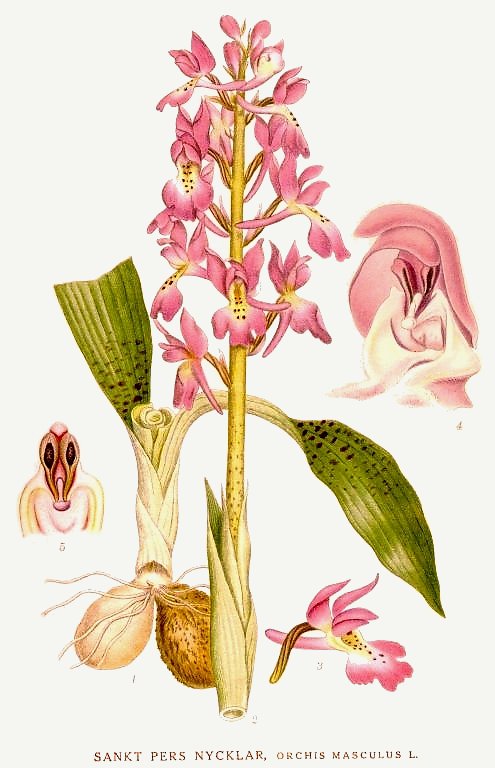
Reproduction of a painting by the Swedish botanist C. A. M. Lindman (1856–1928), taken from his book(s) Bilder ur Nordens Flora (first edition published 1901–1905, supplemented edition 1917–1926).
Source: http://runeberg.org/nordflor/401.html https://commons.wikimedia.org/w/index.php?curid=709470
The literal translation from Latin is testicle – though the derivation may not be apparent from the beauty of the flower. See the paired tubers at the root, however, and it’s clear to see that the reference is anthropomorphic. Incidentally, the medical term for the removal of testicles is … orchidectomy.
Such frankness has origins in bawdier, or at least, less inhibited times. Indeed, such venereal allusions date back at least as Pliny. The old common names in English include dog’s stones (i.e. testicles), fool’s stones, and cullions, in reference to the testicular tubers. A similar set are imaginatively applied in French to the Early Purple and to the Green-winged orchid, Orchis morio L., (now Anacamptis morio), for which the only genteel name I have found is Petite Dame des Prés, Little Lady of the meadows. More typical are such as Couillon de Chien, Couillon de Renard, as in the old English cullions. In Orchis Bouffon, literally Fool’s or Jester’s orchid, the reference is to Fool’s stones, rather than to an idiot per se, just as in English.
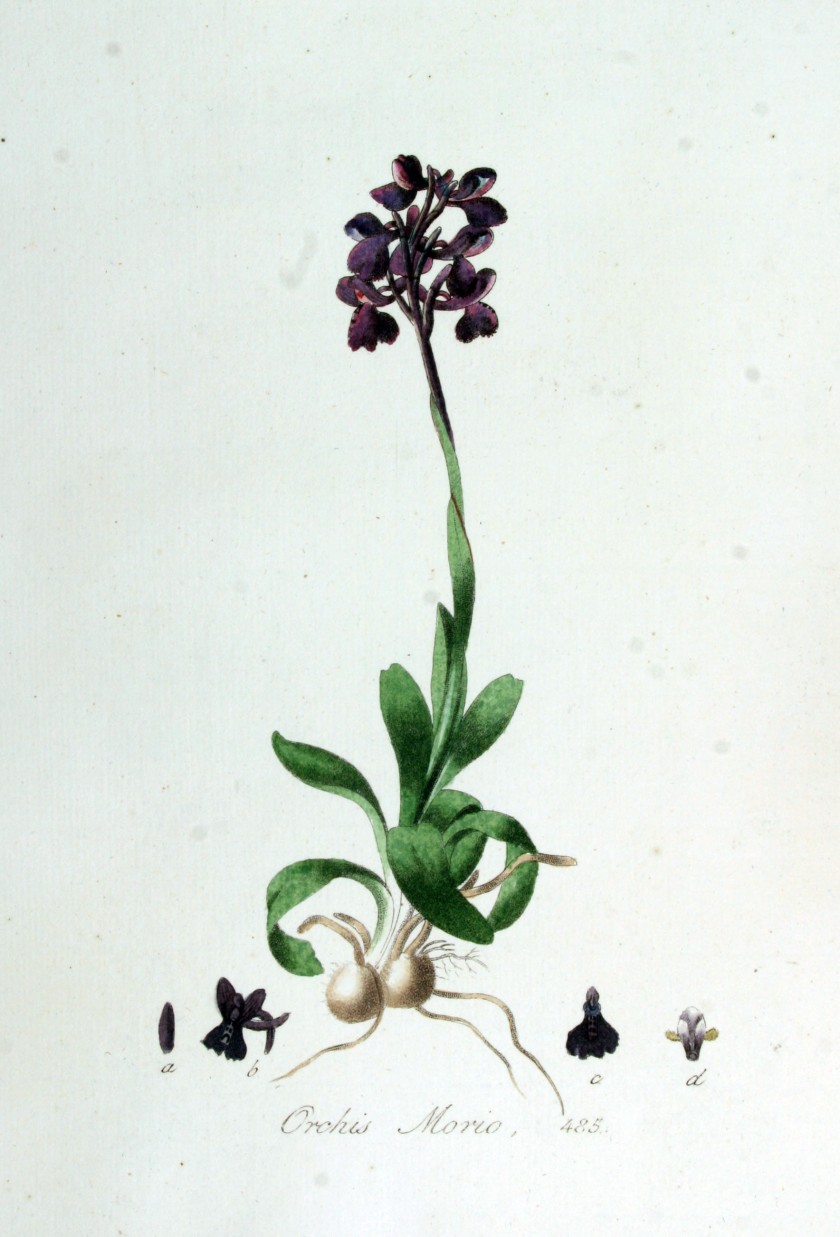
Anacamptis morio, illustrated under its older, Linnean name Orchis morio. From Flora Batava, Volume 7 (1830), Janus (Jan) Kops; Illustrator Christiaan Sepp – http://www.BioLib.de, Public Domain, https://commons.wikimedia.org/w/index.php?curid=18893645
It will come as no surprise to anyone familiar with the Doctrine of Signatures that talismanic and aphrodisiacal virtues were ascribed to the orchid root.
As Dioscorides has it:
… if men do eat of the great full or fat roots of these kinds of dog’s stones, they cause them to beget male children.
In Thessaly, the women give the tender full root to be drunk in goat’s milk to move bodily lust
Maude Grieves describes salep, the concoction prepared from the ground tubers of both O. mascula and A. morio, as a wholesome and nutritious drink, and comments coyly that witches used them in their love potions. Others attribute more earthy qualities – those of a powerful aphrodisiac.
Paracelsus (1493-1541), Alchemist, Physician, Botanist, wrote thus: … behold the Satyrion root, is it not formed like the male privy parts? No one can deny this. Accordingly magic discovered it and revealed that it can restore a man’s virility and passion.
Satyrion is another, older Roman name for Orchis, (8th Century BCE) that derives from the association with satyrs, who ate orchid tubers and were impelled by so doing to their habitual excesses.
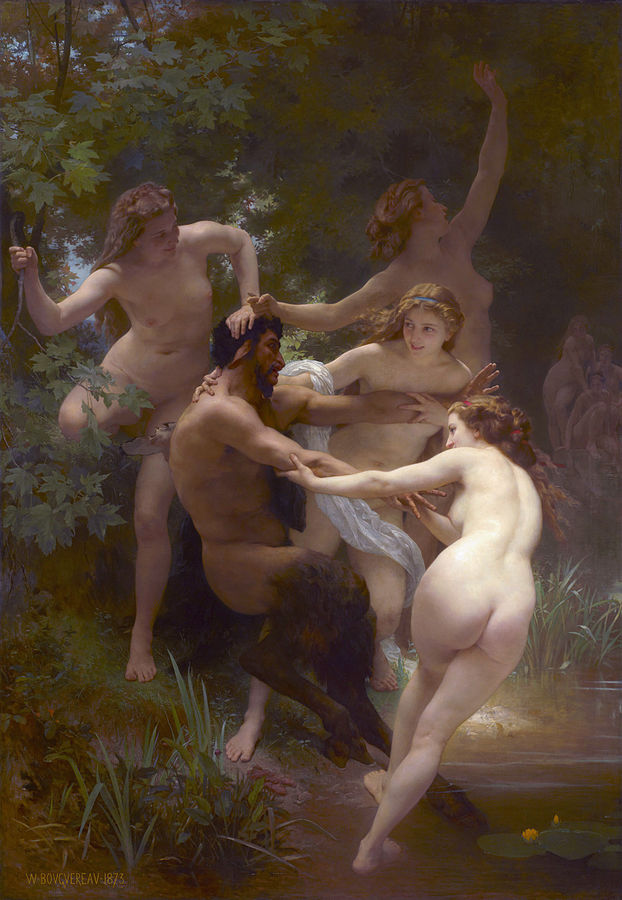
William-Adolphe Bouguereau (1825-1905) – Nymphs and Satyr (1873). https://commons.wikimedia.org/w/index.php?curid=25857924
The Greek name for these orchids was priapiscus. Priāpiscus, πριαπίσκος: a plant that excited passion, fool-stones, orchis.It takes little imagination to see where this is leading. A minor God in all but one respect, the rustic Priapus had responsibilities in the traditional small-god realms of fertility, livestock, fruit and gardens. Oh, and genitalia. He is, of course, best remembered for his huge and painfully permanent erection, which lives on in the modern medical term for the same, priapism.
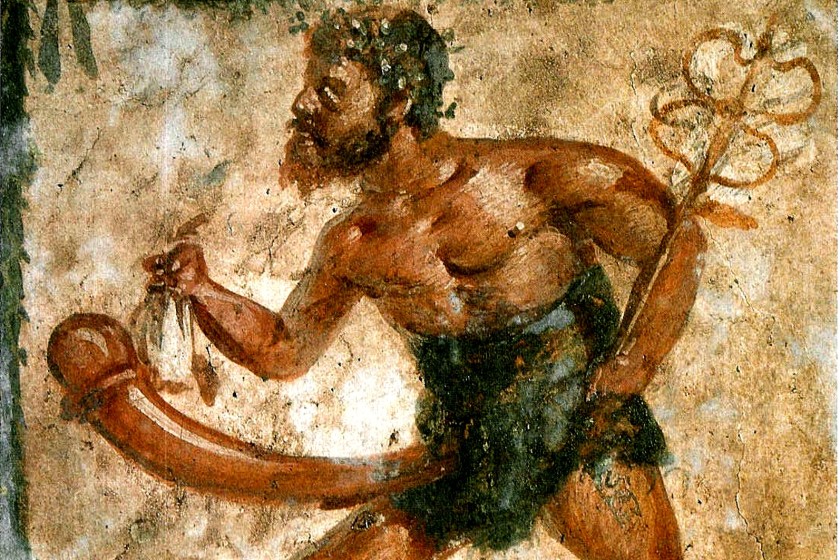
Priapus with Caduceus. Anonymous fresco in Pompeii, between 89 BC and 79 AD. Museo Archeologico Nazionale (Naples), Italia.
In the modern naturalist, orchids do still inflame passions, though now, it seems, a more innocent one than was formerly the case. Find out more by clicking the links below.
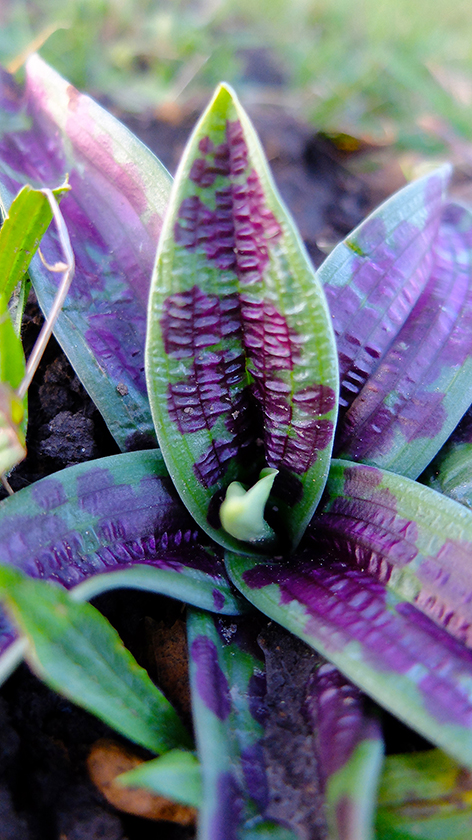
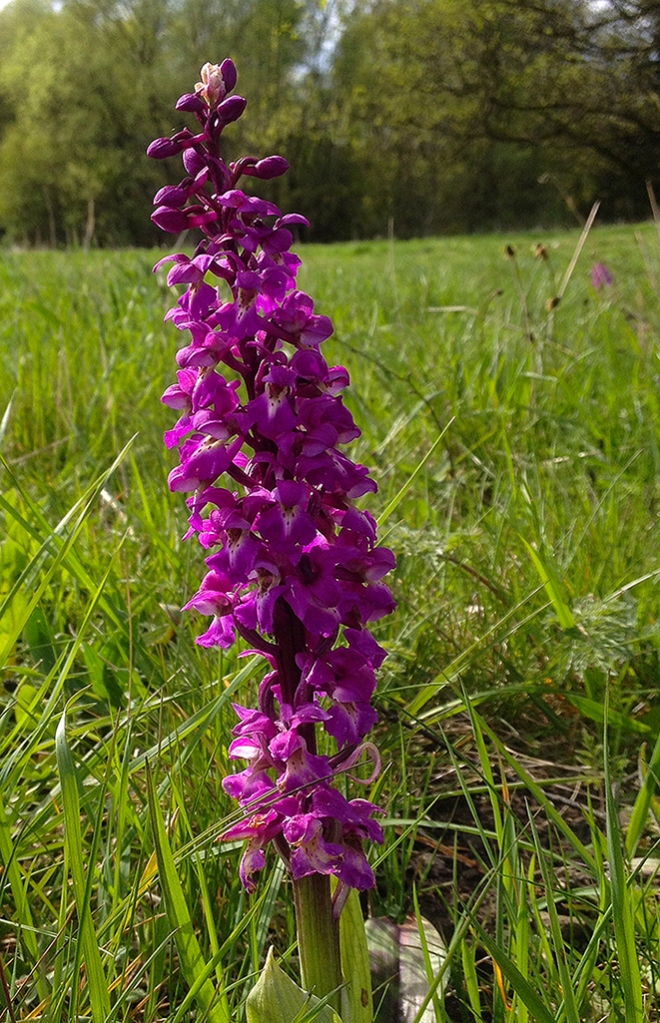
Left: the sumptuous, pleated rosette of Orchis mascula, North Yorkshire roadside verge, spring 2016
Above: Flower spike of Orchis mascula, arising from the rosette shown above.
Orchis mascula (L.) L. Early Purple Orchid. A denizen of woodlands, scrub, and grasslands, also found on road verges, flowering from April to June in the UK.
Species account: http://www.brc.ac.uk/plantatlas/index.php?q=node/805
Distribution map: http://bsbi.org/maps?taxonid=2cd4p9h.caq
National Biodiversity Network data: https://data.nbn.org.uk/Taxa/NBNSYS0000002326

Anacamptis morio (L.) R.M. Bateman, Pridgeon, & M.W. Chase (Orchis morio L.) Green-winged Orchid. The flower colour is variable, ranging from palest pink to red-pink, and purple-violet; it is the upper tepals with green veins that give rise to the common name. A native of grassy habitats including floodplain meadows, flowering from May to June.
Scroll down to see the species account: http://bsbi.org/species-accounts
National Biodiversity Network data: https://data.nbn.org.uk/Taxa/NHMSYS0000455893
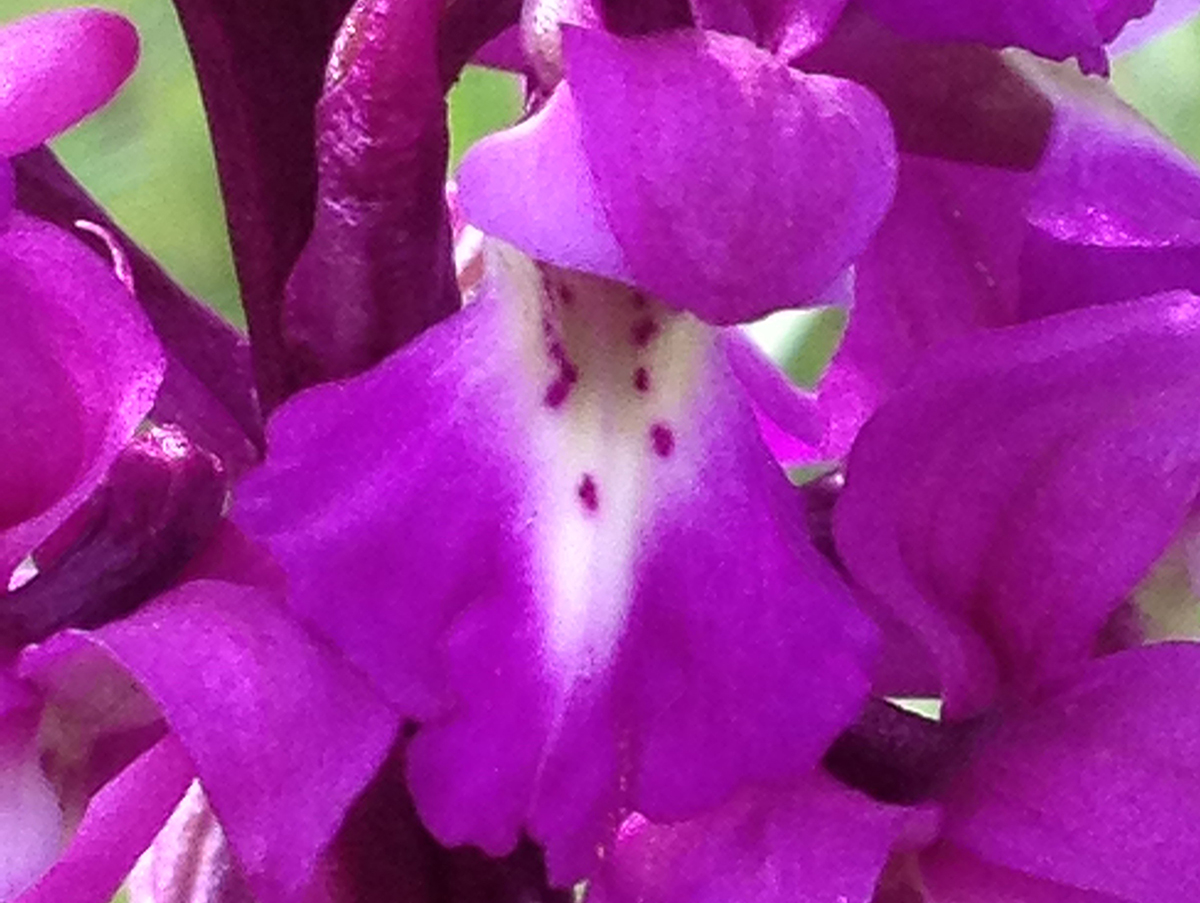
I found your article about orchids fascinating!
I am particularly interested in butterflies and moths, and their vernacular names. I would like to discover more about the historical background of their names. Do you know how I might find out more?
LikeLike
Glad you enjoyed it, Derek. the best reference I have for the names of Lepidoptera is by A. Maitland Emmet, The Scientific Names of the British Lepidoptera. He was a classical scholar and eminent entomologist. I sleep with it under my pillow in the hope of some sort of osmosis. I also rely on Linnaeus, who was a considerable ecologist as well as everything else. So that often the clue to a moth or butterfly’s host plant is found in the Linnaean name. For example, Anthocharis cardamines, the Orange Tip, cross refers to one of its hosts, Cardamine pratensis, the Cuckoo flower. So I also have The Moths of Great Britain and Ireland on my desk, a Latin/English dictionary, along with several Latin plant name references, and frequently cross refer.
So I find that the Campion moth, Hadena rivularis, is named for one of its host plants, Red campion, for example. Sometimes it’s a circuitous route, but always good fun teasing it all out. Linden x
LikeLiked by 1 person
😘
LikeLike
I couldn’t resist commenting. Exceptionally
well written! This is a topic that is close to my heart…
Best wishes! Where are your contact details though?
I really like what you guys are usually up too. This sort of clever work and coverage!
Keep up the good works guys I’ve included you
guys to my personal blogroll. http://foxnews.net
LikeLike